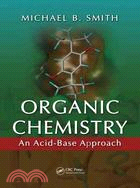Organic Chemistry: An Acid-Base Approach
商品資訊
相關商品
商品簡介
作者簡介
目次
商品簡介
Based on the premise that many, if not most, reactions in organic chemistry can be explained by variations of fundamental acid-base concepts, Organic Chemistry: An Acid-Base Approach provides a framework for understanding the subject that goes beyond mere memorization. The individual steps in many important mechanisms rely on acid-base reactions, and the ability to see these relationships makes understanding organic chemistry easier. Using several techniques to develop a relational understanding, this textbook helps students fully grasp the essential concepts at the root of organic chemistry.
Providing a practical learning experience with numerous opportunities for self-testing, the book contains:
* Checklists of what students need to know before they begin to study a topic
* Checklists of concepts to be fully understood before moving to the next subject area
* Homework problems directly tied to each concept at the end of each chapter
* Embedded problems with answers throughout the material
* Experimental details and mechanisms for key reactions
The reactions and mechanisms contained in the book describe the most fundamental concepts that are used in industry, biological chemistry and biochemistry, molecular biology, and pharmacy. The concepts presented constitute the fundamental basis of life processes, making them critical to the study of medicine. Reflecting this emphasis, most chapters end with a brief section that describes biological applications for each concept. This text provides students with the skills to proceed to the next level of study, offering a fundamental understanding of acids and bases applied to organic transformations and organic molecules.
Providing a practical learning experience with numerous opportunities for self-testing, the book contains:
* Checklists of what students need to know before they begin to study a topic
* Checklists of concepts to be fully understood before moving to the next subject area
* Homework problems directly tied to each concept at the end of each chapter
* Embedded problems with answers throughout the material
* Experimental details and mechanisms for key reactions
The reactions and mechanisms contained in the book describe the most fundamental concepts that are used in industry, biological chemistry and biochemistry, molecular biology, and pharmacy. The concepts presented constitute the fundamental basis of life processes, making them critical to the study of medicine. Reflecting this emphasis, most chapters end with a brief section that describes biological applications for each concept. This text provides students with the skills to proceed to the next level of study, offering a fundamental understanding of acids and bases applied to organic transformations and organic molecules.
作者簡介
Michael B. Smith is a professor of chemistry in the Department of Chemistry at the University of Connecticut, at Storrs. His research interests focus on the identification of bioactive lipids from the dental pathogen Porphyromonas gingivalis, exploration of the use of conducting polymers as a neutral reaction medium for chemical transformations, development of fluorescent probes for the detection of cancerous tumors, and the synthesis of phenanthridone alkaloids. He is also the author of volumes 6-12 of the Compendium of Organic Synthetic Methods and coauthor of the fifth and sixth editions and upcoming seventh edition of March’s Advanced Organic Chemistry. He is the author of the first, second, and upcoming third edition of Organic Synthesis, as well as several monographs. Dr. Smith received his PhD in organic chemistry from Purdue University in 1977.
目次
Introduction
A Brief History of Organic Chemistry
The Variety and Beauty of Organic Molecules
Why Is an Acid-BaseTheme Important?
Acids and Bases in General Chemistry
Acids and Bases in Organic Chemistry
How Are the Two Acid-Base Definitions Related?
Acid and Base Strength
Lewis Acids and Lewis Bases
Why Is Acid-Base Chemistry a Theme for Organic Chemistry?
Biological Relevance
Bonding
The Elements
What Is a Chemical Bond? Ionic versus Covalent
The Covalent Carbon-Carbon Bond
Molecular Orbitals
Tetrahedral Carbons and sp3 Hybridization
How Strong Is a Covalent Bond? Bond Dissociation Energy
Polarized Covalent σ-Bonds
Biological Relevance
Alkanes, Isomers, and an Introduction to Nomenclature
The Fundamental Structure of Alkanes Based on the sp3 Hybrid Model
Millions of Hydrocarbons: Alkanes
Combustion Analysis and Empirical Formulas
The Acid or Base Properties of Alkanes
Isomers
Naming Millions of Isomers: Rules of Nomenclature. The IUPAC Rules of Nomenclature
Rings Made of Carbon. Cyclic Compounds
Biological Relevance
Functional Groups
Introducing a Functional Group: Alkenes
Another Hydrocarbon Functional Group: Alkynes
Hydrocarbons with Several Multiple Bonds
Reactivity of Polarized Covalent σ-Bonds
Formal Charge
Heteroatom Functional Groups
Acid-Base Properties of Functional Groups
Polarity and Intermolecular Forces
Functional Groups with Polarized π-Bonds
Benzene: A Special Cyclic Hydrocarbon
Biological Relevance
Acids, Bases, Nucleophiles, and Electrophiles
Acid-Base Equilibria
Polarized Hydrogen-Heteroatom Bonds: Acidic Units
Factors That Influence the Strength of a Brønsted-Lowry Acid
Organic Bases
Lewis Acids and Lewis Bases
A Positive Carbon Atom Can Accept Electrons
Nucleophiles
Biological Relevance
Chemical Reactions, Bond Energy, and Kinetics
A Chemical Reaction
Bond Dissociation Enthalpy and Reactions
Transition States
Reactive Intermediates
Free Energy. Influence of Enthalpy and Entropy
Energetics. Starting Materials, Transition States, Intermediates, and Products on a Reaction Curve
Competing Reactions
Mechanisms
Why Does a Chemical Reaction Occur? Defining a "Reactive" Center
Reversible Chemical Reactions
Kinetics
No Reaction
Biological Relevance
Rotamers and Conformation
Rotamers
Longer Chain Alkanes: Increased Torsional Strain
Conformations of Alkenes and Alkynes: Introducing π-Bonds
Influence of Heteroatoms on the Rotamer Population
Cyclic Alkanes
Substituted Cyclohexanes
Larger Rings
Cyclic Alkenes
Introducing Heteroatoms into a Ring
Biological Relevance
Stereoisomers: Chirality, Enantiomers, and Diastereomers
Stereogenic Carbons and Stereoisomers
Specific Rotation: A Physical Property
Absolute Configuration (R and S Nomenclature)
Alkenes
Diastereomers
Stereogenic Centers in Cyclic Molecules
Stereogenic Centers in Complex Molecules
Optical Resolution
Biological Relevance
Acid-Base Reactions of π-Bonds
Alkenes and Acid-Base Chemistry
Carbocation Intermediates
Alkenes React with Weak Acids in the Presence of an Acid Catalyst
Alkenes React as Lewis Bases
Alkenes React as Lewis Bases with Electrophilic Oxygen. Oxidation of Alkenes to Oxiranes
Alkynes React as Brønsted-Lowry Bases or Lewis Bases
Reactions That Are Not Formally Acid-Base Reactions
Non-ionic Reactions: Radical Intermediates and Alkene Polymerization
Synthetic Transformations
Biological Relevance
Nucleophiles: Lewis Base-Like Reactions at sp3 Carbon
Alkyl Halides, Sulfonate Esters, and the Electrophilic C-X Bond
Nucleophiles and Bimolecular Substitution (the SN2 Reaction)
Functional Group Transformations via the SN2 Reaction
A Tertiary Halide Reacts with a Nucleophile When the Solvent Is Water
Carbocation Rearrangements
Solvolysis Reactions of Alkyl Halides
Preparation of Halides and Sulfonate Esters by Substitution Reactions
Reactions of Ethers
Free Radical Halogenation of Alkanes
Applications to Synthesis
Biological Relevance
Base-Induced Elimination Reactions
Bimolecular Elimination
Stereochemical Consequences of the E2 Reaction
The E2 Reaction in Cyclic Molecules
Unimolecular Elimination
Intramolecular Elimination
1,3 Elimination: Decarboxylation
Elimination Reactions of Vinyl Halides: Formation of Alkynes
Elimination Functional Group Exchanges
Biological Relevance
Substitution and Elimination Reactions Can Compete
A Few Simplifying Assumptions
Protic versus Aprotic and Water
Nucleophilic Strength versus Base Strength
The Nature of the Halide
What about Secondary Halides?
Strength and Limitations of the Simplifying Assumptions
When Do the Assumptions Fail?
Spectroscopic Methods of Identification
Light and Energy
Mass Spectrometry
Infrared Spectroscopy
Nuclear Magnetic Resonance Spectroscopy
The Structure of an Unknown Molecule May Be Determined
Carbon-13 NMR Spectroscopy: Counting the Carbons
Biological Relevance
Organometallic Reagents
Introducing Magnesium into a Molecule
Reaction of Aryl and Vinyl Halides with Magnesium
Grignard Reagents Are Bases
Grignard Reagents Are Poor Nucleophiles with Alkyl Halides
Organolithium Reagents
Organocuprates
Organometallic Disconnections
Biological Relevance
Carbonyl Compounds: Structure, Nomenclature, Reactivity
The Carbonyl Group
Aldehydes and Ketones. Nomenclature
Chemical Reactivity of Ketones and Aldehydes
Carboxylic Acids. Nomenclature and Properties
Dicarboxylic Acids
Dicarboxylic Acids Have Two pKa Values
Carboxylic Acid Derivatives. Nomenclature and Properties
Acyl Substitution with Carboxylic Acid Derivatives
Sulfonic Acids
Biological Relevance
Oxidation
Defining an Oxidation
Oxidation of Alcohols with Chromium(VI)
Oxidation of Alkenes
Oxidative Cleavage
Summary of Functional Group Exchanges
Biological Relevance
Reactions of Aldehydes and Ketones
Chemical Reactivity of the Carbonyl Group
Reversible versus Irreversible Acyl Addition
Reaction of Aldehydes or Ketones with Strong Nucleophiles
Organometallic Reagents Are Nucleophiles
Water: A Weak Nucleophile That Gives Reversible Acyl Addition
Alcohols: Neutral Nucleophiles That Give Reactive Products
Amines Are Nucleophiles That React to Give Imines or Enamines
Carbon-Carbon Bond-Forming Reactions and Functional Group Modification
Biological Relevance
Reduction
Defining a Reduction
Hydrides as Reducing Agents
Catalytic Hydrogenation
Dissolving Metal Reductions
Summary of Functional Group Exchanges
Biological Relevance
Carboxylic Acid Derivatives and Acyl Substitution
Chemical Reactivity of Carboxylic Acid Derivatives
Acyl Substitution. Acid Derivatives React with Water: Hydrolysis
Preparation of Acid Chlorides
Preparation of Acid Anhydrides
Preparation of Esters
Amides
The Reaction of Carboxylic Acid Derivatives with Carbon Nucleophiles
Reaction of Organometallics with Other Electrophilic "Carbonyl" Molecules
Dicarboxylic Acid Derivatives
Baeyer-Villiger Oxidation
Sulfonic Acid Derivatives
Sulfate Esters and Phosphate Esters
Nitriles Are Carboxylic Acid Derivatives
Carbon-Carbon Bond-Forming Reactions and Functional Group Exchanges of Acid Derivatives
Biological Relevance
Aromatic Compounds and Benzene Derivatives
Benzene and Aromaticity
Functionalized Benzene Derivatives and a New Nomenclature System
Electrophilic Aromatic Substitution
Disubstituted Benzene Derivatives
Polysubstituted Benzene Derivatives
Reduction of Aromatic Compounds
Aromaticity in Monocyclic Molecules Other Than Benzene
Polynuclear Aromatic Hydrocarbons
Aromatic Amines and Diazonium Salts
Nucleophilic Aromatic Substitution
Aromatic Disconnections and Functional Group Exchange Reactions
Synthesis of Aromatic Compounds
Biological Relevance
Enolate Anions: Acyl Addition and Acyl Substitution
Aldehydes and Ketones Are Weak Acids
Enolate Anions Are Nucleophiles. The Aldol Condensation
Non-nucleophilic Bases
Enolate Anions from Unsymmetrical Ketones
Dehydration of Aldol Products
The Intramolecular Aldol Condensation
Ester Enolates
Decarboxylation
Enolate Alkylation
Phosphorus Ylids and the Wittig Reaction
Many New Synthetic Possibilities
Biological Relevance
Difunctional Molecules: Dienes and Conjugated Carbonyl Compounds
Conjugated Dienes
Conjugated Carbonyl Compounds
Detecting Conjugation: Ultraviolet Spectroscopy
Reactions of Conjugated π-Bonds
Polymers from Conjugated Molecules
Synthetic Possibilities
Biological Relevance
Difunctional Molecules: Pericyclic Reactions
Frontier Molecular Orbitals: HOMOs and LUMOs
Reactivity of Dienes and Alkenes
Selectivity
Sigmatropic Rearrangements
Review of Synthetic Transformations
Biological Relevance
Disconnections and Synthesis
What Is Synthesis?
Specifying a Starting Material for a Given Target
The Starting Material Is Unknown
Disconnection of Molecules with Problematic Structural Features
Heteroaromatic Compounds
Nitrogen in an Aromatic Ring
Oxygen and Sulfur in an Aromatic Ring
Substitution Reactions in Heterocyclic Aromatic Compounds
Reduced Forms of Heterocycles
Heteroaromatic Compounds with More Than One Ring
Aromatic Substitution Reactions of Polycyclic Heterocycles
Synthesis of Heterocycles
Biological Relevance
Multifunctional Compounds: Amino Acids and Peptides
A Review of Reactions That Form Amines
Reactions of Amines
Difunctional Molecules: Amino Acids
Biological Relevance. Peptides Are Polyamides of Amino Acid Residues
Biological Relevance. Proteins and Enzymes Are Polypeptides
New Synthetic Methodology
Multifunctional Compounds: Carbohydrates
Polyhydroxy Carbonyl Compounds
Biological Relevance. Oligosaccharides and Polysaccharides
Reactions of Carbohydrates
Synthesis of Carbohydrates
Biological Relevance. Nucleosides and Nucleotides (Heterocycles Combined with Sugars)
Biological Relevance. Polynucleotides
Synthesis of Polynucleotides
Index
A Brief History of Organic Chemistry
The Variety and Beauty of Organic Molecules
Why Is an Acid-BaseTheme Important?
Acids and Bases in General Chemistry
Acids and Bases in Organic Chemistry
How Are the Two Acid-Base Definitions Related?
Acid and Base Strength
Lewis Acids and Lewis Bases
Why Is Acid-Base Chemistry a Theme for Organic Chemistry?
Biological Relevance
Bonding
The Elements
What Is a Chemical Bond? Ionic versus Covalent
The Covalent Carbon-Carbon Bond
Molecular Orbitals
Tetrahedral Carbons and sp3 Hybridization
How Strong Is a Covalent Bond? Bond Dissociation Energy
Polarized Covalent σ-Bonds
Biological Relevance
Alkanes, Isomers, and an Introduction to Nomenclature
The Fundamental Structure of Alkanes Based on the sp3 Hybrid Model
Millions of Hydrocarbons: Alkanes
Combustion Analysis and Empirical Formulas
The Acid or Base Properties of Alkanes
Isomers
Naming Millions of Isomers: Rules of Nomenclature. The IUPAC Rules of Nomenclature
Rings Made of Carbon. Cyclic Compounds
Biological Relevance
Functional Groups
Introducing a Functional Group: Alkenes
Another Hydrocarbon Functional Group: Alkynes
Hydrocarbons with Several Multiple Bonds
Reactivity of Polarized Covalent σ-Bonds
Formal Charge
Heteroatom Functional Groups
Acid-Base Properties of Functional Groups
Polarity and Intermolecular Forces
Functional Groups with Polarized π-Bonds
Benzene: A Special Cyclic Hydrocarbon
Biological Relevance
Acids, Bases, Nucleophiles, and Electrophiles
Acid-Base Equilibria
Polarized Hydrogen-Heteroatom Bonds: Acidic Units
Factors That Influence the Strength of a Brønsted-Lowry Acid
Organic Bases
Lewis Acids and Lewis Bases
A Positive Carbon Atom Can Accept Electrons
Nucleophiles
Biological Relevance
Chemical Reactions, Bond Energy, and Kinetics
A Chemical Reaction
Bond Dissociation Enthalpy and Reactions
Transition States
Reactive Intermediates
Free Energy. Influence of Enthalpy and Entropy
Energetics. Starting Materials, Transition States, Intermediates, and Products on a Reaction Curve
Competing Reactions
Mechanisms
Why Does a Chemical Reaction Occur? Defining a "Reactive" Center
Reversible Chemical Reactions
Kinetics
No Reaction
Biological Relevance
Rotamers and Conformation
Rotamers
Longer Chain Alkanes: Increased Torsional Strain
Conformations of Alkenes and Alkynes: Introducing π-Bonds
Influence of Heteroatoms on the Rotamer Population
Cyclic Alkanes
Substituted Cyclohexanes
Larger Rings
Cyclic Alkenes
Introducing Heteroatoms into a Ring
Biological Relevance
Stereoisomers: Chirality, Enantiomers, and Diastereomers
Stereogenic Carbons and Stereoisomers
Specific Rotation: A Physical Property
Absolute Configuration (R and S Nomenclature)
Alkenes
Diastereomers
Stereogenic Centers in Cyclic Molecules
Stereogenic Centers in Complex Molecules
Optical Resolution
Biological Relevance
Acid-Base Reactions of π-Bonds
Alkenes and Acid-Base Chemistry
Carbocation Intermediates
Alkenes React with Weak Acids in the Presence of an Acid Catalyst
Alkenes React as Lewis Bases
Alkenes React as Lewis Bases with Electrophilic Oxygen. Oxidation of Alkenes to Oxiranes
Alkynes React as Brønsted-Lowry Bases or Lewis Bases
Reactions That Are Not Formally Acid-Base Reactions
Non-ionic Reactions: Radical Intermediates and Alkene Polymerization
Synthetic Transformations
Biological Relevance
Nucleophiles: Lewis Base-Like Reactions at sp3 Carbon
Alkyl Halides, Sulfonate Esters, and the Electrophilic C-X Bond
Nucleophiles and Bimolecular Substitution (the SN2 Reaction)
Functional Group Transformations via the SN2 Reaction
A Tertiary Halide Reacts with a Nucleophile When the Solvent Is Water
Carbocation Rearrangements
Solvolysis Reactions of Alkyl Halides
Preparation of Halides and Sulfonate Esters by Substitution Reactions
Reactions of Ethers
Free Radical Halogenation of Alkanes
Applications to Synthesis
Biological Relevance
Base-Induced Elimination Reactions
Bimolecular Elimination
Stereochemical Consequences of the E2 Reaction
The E2 Reaction in Cyclic Molecules
Unimolecular Elimination
Intramolecular Elimination
1,3 Elimination: Decarboxylation
Elimination Reactions of Vinyl Halides: Formation of Alkynes
Elimination Functional Group Exchanges
Biological Relevance
Substitution and Elimination Reactions Can Compete
A Few Simplifying Assumptions
Protic versus Aprotic and Water
Nucleophilic Strength versus Base Strength
The Nature of the Halide
What about Secondary Halides?
Strength and Limitations of the Simplifying Assumptions
When Do the Assumptions Fail?
Spectroscopic Methods of Identification
Light and Energy
Mass Spectrometry
Infrared Spectroscopy
Nuclear Magnetic Resonance Spectroscopy
The Structure of an Unknown Molecule May Be Determined
Carbon-13 NMR Spectroscopy: Counting the Carbons
Biological Relevance
Organometallic Reagents
Introducing Magnesium into a Molecule
Reaction of Aryl and Vinyl Halides with Magnesium
Grignard Reagents Are Bases
Grignard Reagents Are Poor Nucleophiles with Alkyl Halides
Organolithium Reagents
Organocuprates
Organometallic Disconnections
Biological Relevance
Carbonyl Compounds: Structure, Nomenclature, Reactivity
The Carbonyl Group
Aldehydes and Ketones. Nomenclature
Chemical Reactivity of Ketones and Aldehydes
Carboxylic Acids. Nomenclature and Properties
Dicarboxylic Acids
Dicarboxylic Acids Have Two pKa Values
Carboxylic Acid Derivatives. Nomenclature and Properties
Acyl Substitution with Carboxylic Acid Derivatives
Sulfonic Acids
Biological Relevance
Oxidation
Defining an Oxidation
Oxidation of Alcohols with Chromium(VI)
Oxidation of Alkenes
Oxidative Cleavage
Summary of Functional Group Exchanges
Biological Relevance
Reactions of Aldehydes and Ketones
Chemical Reactivity of the Carbonyl Group
Reversible versus Irreversible Acyl Addition
Reaction of Aldehydes or Ketones with Strong Nucleophiles
Organometallic Reagents Are Nucleophiles
Water: A Weak Nucleophile That Gives Reversible Acyl Addition
Alcohols: Neutral Nucleophiles That Give Reactive Products
Amines Are Nucleophiles That React to Give Imines or Enamines
Carbon-Carbon Bond-Forming Reactions and Functional Group Modification
Biological Relevance
Reduction
Defining a Reduction
Hydrides as Reducing Agents
Catalytic Hydrogenation
Dissolving Metal Reductions
Summary of Functional Group Exchanges
Biological Relevance
Carboxylic Acid Derivatives and Acyl Substitution
Chemical Reactivity of Carboxylic Acid Derivatives
Acyl Substitution. Acid Derivatives React with Water: Hydrolysis
Preparation of Acid Chlorides
Preparation of Acid Anhydrides
Preparation of Esters
Amides
The Reaction of Carboxylic Acid Derivatives with Carbon Nucleophiles
Reaction of Organometallics with Other Electrophilic "Carbonyl" Molecules
Dicarboxylic Acid Derivatives
Baeyer-Villiger Oxidation
Sulfonic Acid Derivatives
Sulfate Esters and Phosphate Esters
Nitriles Are Carboxylic Acid Derivatives
Carbon-Carbon Bond-Forming Reactions and Functional Group Exchanges of Acid Derivatives
Biological Relevance
Aromatic Compounds and Benzene Derivatives
Benzene and Aromaticity
Functionalized Benzene Derivatives and a New Nomenclature System
Electrophilic Aromatic Substitution
Disubstituted Benzene Derivatives
Polysubstituted Benzene Derivatives
Reduction of Aromatic Compounds
Aromaticity in Monocyclic Molecules Other Than Benzene
Polynuclear Aromatic Hydrocarbons
Aromatic Amines and Diazonium Salts
Nucleophilic Aromatic Substitution
Aromatic Disconnections and Functional Group Exchange Reactions
Synthesis of Aromatic Compounds
Biological Relevance
Enolate Anions: Acyl Addition and Acyl Substitution
Aldehydes and Ketones Are Weak Acids
Enolate Anions Are Nucleophiles. The Aldol Condensation
Non-nucleophilic Bases
Enolate Anions from Unsymmetrical Ketones
Dehydration of Aldol Products
The Intramolecular Aldol Condensation
Ester Enolates
Decarboxylation
Enolate Alkylation
Phosphorus Ylids and the Wittig Reaction
Many New Synthetic Possibilities
Biological Relevance
Difunctional Molecules: Dienes and Conjugated Carbonyl Compounds
Conjugated Dienes
Conjugated Carbonyl Compounds
Detecting Conjugation: Ultraviolet Spectroscopy
Reactions of Conjugated π-Bonds
Polymers from Conjugated Molecules
Synthetic Possibilities
Biological Relevance
Difunctional Molecules: Pericyclic Reactions
Frontier Molecular Orbitals: HOMOs and LUMOs
Reactivity of Dienes and Alkenes
Selectivity
Sigmatropic Rearrangements
Review of Synthetic Transformations
Biological Relevance
Disconnections and Synthesis
What Is Synthesis?
Specifying a Starting Material for a Given Target
The Starting Material Is Unknown
Disconnection of Molecules with Problematic Structural Features
Heteroaromatic Compounds
Nitrogen in an Aromatic Ring
Oxygen and Sulfur in an Aromatic Ring
Substitution Reactions in Heterocyclic Aromatic Compounds
Reduced Forms of Heterocycles
Heteroaromatic Compounds with More Than One Ring
Aromatic Substitution Reactions of Polycyclic Heterocycles
Synthesis of Heterocycles
Biological Relevance
Multifunctional Compounds: Amino Acids and Peptides
A Review of Reactions That Form Amines
Reactions of Amines
Difunctional Molecules: Amino Acids
Biological Relevance. Peptides Are Polyamides of Amino Acid Residues
Biological Relevance. Proteins and Enzymes Are Polypeptides
New Synthetic Methodology
Multifunctional Compounds: Carbohydrates
Polyhydroxy Carbonyl Compounds
Biological Relevance. Oligosaccharides and Polysaccharides
Reactions of Carbohydrates
Synthesis of Carbohydrates
Biological Relevance. Nucleosides and Nucleotides (Heterocycles Combined with Sugars)
Biological Relevance. Polynucleotides
Synthesis of Polynucleotides
Index
主題書展
更多
主題書展
更多書展本週66折
您曾經瀏覽過的商品
購物須知
為了保護您的權益,「三民網路書店」提供會員七日商品鑑賞期(收到商品為起始日)。
若要辦理退貨,請在商品鑑賞期內寄回,且商品必須是全新狀態與完整包裝(商品、附件、發票、隨貨贈品等)否則恕不接受退貨。

























